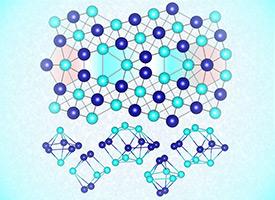

02/22/2021

© 2021 Kazutoshi Inoue
The atomic structures of regions near boundaries between adjacent crystals in polycrystalline materials can be characterized by certain types of polyhedra, AIMR researchers have shown1. This promises to make it easier to model these materials and to predict their properties.
Many materials, including lots of metals and ceramics, are three-dimensional (3D) mosaics of microscopic crystals, all with different sizes and orientations. Several properties of such polycrystalline materials are strongly affected by how the atoms are arranged near the boundaries where two crystals, or grains, meet. But the breakdown of the regular structural order near these grain boundaries has made it extremely challenging to analyze and model the structure and properties of grain boundaries.
A crystal with a face-centered cubic structure — the crystal structure of metals such as aluminum, copper and gold — can be considered to be made up of adjacent four-sided (tetrahedra) or eight-sided (octahedra) shapes.
Now, Kazutoshi Inoue of AIMR at Tohoku University and his co-workers have shown that it is also possible to analyze regions near grain boundaries in terms of atomic polyhedra (see image). They did this by analyzing the 3D polyhedral structure of face-centered cubic crystals for certain types of grain boundaries.
“We discovered that regions close to grain boundaries can be packed only by the bulk polyhedral units (that is, tetrahedra and octahedra) or grain-boundary-type polyhedral units that differ from the bulk ones,” says Inoue. “This extends the current framework, which focuses on two-dimensional models, to define 3D structural units to cover all the grain boundaries in cubic crystals.”
The researchers also uncovered a surprising connection between the atomic structure of grain boundaries and the properties of fractions, which can be visually represented in mathematical figures known as Farey diagrams.
“We found a one-to-one correspondence between the 3D atomic structures of grain boundaries and the distribution of rational numbers,” says Inoue. “It’s surprising that the grain-boundary hierarchy can be completely and quantitatively described by a modified version of the Farey diagram, which also represents the mathematical structures of other physical and biological phenomena, including phenomena involving oscillations and the arrangement of leaves on a stalk.” This connection will enable researchers to readily estimate the 3D arrangement of grain boundaries.
The team intends to use their analysis method in conjunction with microscopic observations to determine the conditions for realizing stable atomic structures at grain boundaries. “This is both of fundamental interest and important for designing high-performance materials,” says Inoue.
This research highlight has been approved by the authors of the original article and all information and data contained within has been provided by said authors.